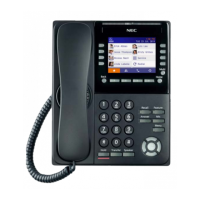– 55 –
CHAPTER 4 OFFICE DATA DESIGN
STEP 3: Delete the supervisory position data in ACDPSN.
STEP 4: Delete the function key data of the supervisory position in AKYD.
STEP 5: Delete the station data of the supervisory position in ASDT.
2.5 ID Code Assignment
When the split needs Logon ID, assign ID code to each operator using ACDLOG command. Note 1
Note 1:
An ID code may be used for only one position at any given time. Multiple logons with same ID are not per-
mitted.
STEP 1: ACDSPL - LOGID=1 (Required)
STEP 2: ACDLOG - Assign Logon ID and the related data of services activated individually by the pro-
grammed ID code.
TN: Tenant Number (1-9)
LID: Logon ID (Max. 9 digits)
NAME: Logon ID Name (up to 14 characters)
LANG: Default language
0 = English
1 = Japanese
2 = Spanish
3 = Italian
4 = French
5 = German
SPLIT: Available Split number (1-250)
Note 2
Note 2:
Enter the space for all splits available.
PRIO: Priority for handling ACD calls in multiple splits/the agents preference level when
AGT-Q=1 in ACDSPL (1-99)
MULTS: 0/1=Single split/Multi split
PARN: Dial number of individual Assistance call (max. 5 digits)
PERN: Dial number of individual Emergency call (max. 5 digits)
PPN: Pilot number for an individual call (max. 5 digits)
MXQD: Maximum Queue Depth for an incoming call routed to the agent (0-999)
Note 3
Note 3:
Available for 0-9999 when additional method is used.
GOCF NO: CCV No. to be routed when the individual call encounters busy status (1-900)
GOCF STP: CCV step number to be forwarded when the individual call encounters busy status (1-20)
OVFT: Overflow Timeout (0-9999 sec.)
GOCO NO: CCV number to be routed when the time limit (OVFT) is over (1-900)
GOCO STP: CCV step number to be routed when the time limit (OVFT) is over (1-20)
PCWCM: 0=Call waiting chime is not available
1=Call waiting chime is rung only once (at the first time)
2=Call waiting chime is rung every time
NAMES: abbreviation of Logon ID Name (max. 5 characters)

